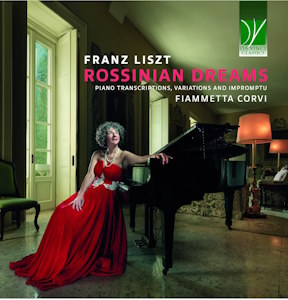
Rossinian Dreams
Franz Liszt (1811-1886)
Variations Brilliantes sur un thème de Rossini S.149 (c.1824)
Transcriptions d’aprés Rossini S.553 (1847): No.1 Air du Stabat Mater; No.2 La Charité
Impromptu brilliant sur des thèmes de Rossini et Spontini S.150 (c.1824)
Gioachino Rossini (1792-1868)
Sinfonia from La Gazza Ladra (anonymous arrangement)
Fiammetta Corvi (piano)
rec. 2022, Como, Italy
Da Vinci Classics C00727 [53]
Liszt’s mission to bring the music of other composers to a wider public is well documented and remarkably well represented in recordings. Nowadays if we want to hear Rossini’s Ermione, La Donna del Lago and Armida or Gaspare Spontini’s Olympie and Fernand Cortez they are all available at the click of a button so we mostly approach the transcriptions and arrangements by Liszt and others from what we learn about the arranger rather than the composer and, it must be said, the pure joy of listening to them. Fiammetta Corvi shows us two stages in Liszt’s life, first the young virtuoso, roughly thirteen at the time he wrote the Variations brilliantes and Impromptu brilliant and then the older composer, more mature in his craft, magnificently recreating Rossini’s vocal works in terms of the piano.
The recital opens and closes with the early works. The variations are pretty standard stuff for the time; a dramatic introduction that hints at the theme, the theme itself and its collection of virtuoso variations. The influence of his teacher Carl Czerny is clear in the series of runs, scales in thirds and fourths, arpeggios, treacherous leaps across the keyboard and more and this continues into the impromptu though this is a little more varied. A dramatic introduction – evidently an essential element – features music that Liszt was to re-use in Eroica from his transcendental études. What follows are themes from several operas all tied together in a stylish package with some interesting harmonic turns and fanciful writing along the way. Even as a young man he has a natural sense of pacing and the coda based around the Duo from Armida is thrilling. Liszt returned to Rossini a quarter of a century later with transcriptions of the tenor area Cujus animam and La Charité. Both display the skills that Liszt has developed in the intervening years and the virtuosity of the writing in no way disguises the impact of Rossini’s melody. Thalberg’s famous three hand technique in which the melody is played by the thumbs leaving the rest of the digits to provide accompaniment and decoration above and below – hence giving the impression of three hands playing – is given free reign here and this works especially well in the beautiful La Charité originally written for female voices and piano. Liszt being Liszt he shifts the solo soprano line into the baritone register where it sounds wonderful. A glance at the score shows the challenges facing the pianist; the melody line seems submerged in a welter of arpeggios and other figuration out of which the pianist must find a satisfying and at times quite delicate balance. Both of these pieces demonstrate Liszt’s command and understanding of the piano as well as his keen ear for textures so it is odd that the remaining item in this assortment of Rossiniana is an undated and anonymous arrangement of the overture to La Gazza Ladra published by Ricordi. I say odd in that this is a very literal and straightforward arrangement to which one can’t imagine Liszt would have spared a second glance. Looking through his exceptional arrangements of overtures by the likes of Berlioz, Weber and, apropos this recital, Rossini one is aware of the vast gulf between his imagination and that of the anonymous writer here. If it was felt that Liszt’s William Tell transcription wasn’t suitable here there are other Rossini items that would have fitted the bill more appropriately – his Grande Fantaisie on the Soirée Musicales or selections from the twelve Soirée Musicales that Liszt arranged in 1837 for example. It does not help that Corvi takes the overture’s allegro at a fairly sedate pace; our anonymous arranger marks dotted minim equals 63 and listening through a selection of orchestral versions gave me dotted minim of between 56 and 64. Corvi plays at 49 and much of the buoyancy of the piece is tempered. Elsewhere Corvi tackles these works with assurance and finesse and I admire her elegance and sense of balance in the Liszt items, particularly La Charité. Even if I am not impressed with the arrangement of la Gazza Ladra it is still Rossini and combining the melodiousness of Rossini with the extravagance of Liszt will always be a winning combination; this is an attractive way to hear some entertaining Liszt that is hardly ever played. I prefer Leslie Howard’s way with these pieces (available as downloads from Hyperion Records) as he has the edge in terms of technique and character but this is a good version nonetheless.
Rob Challinor
Availability: Da Vinci Classics
















